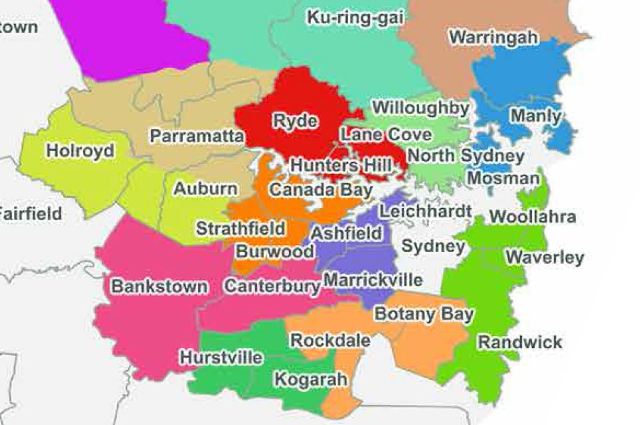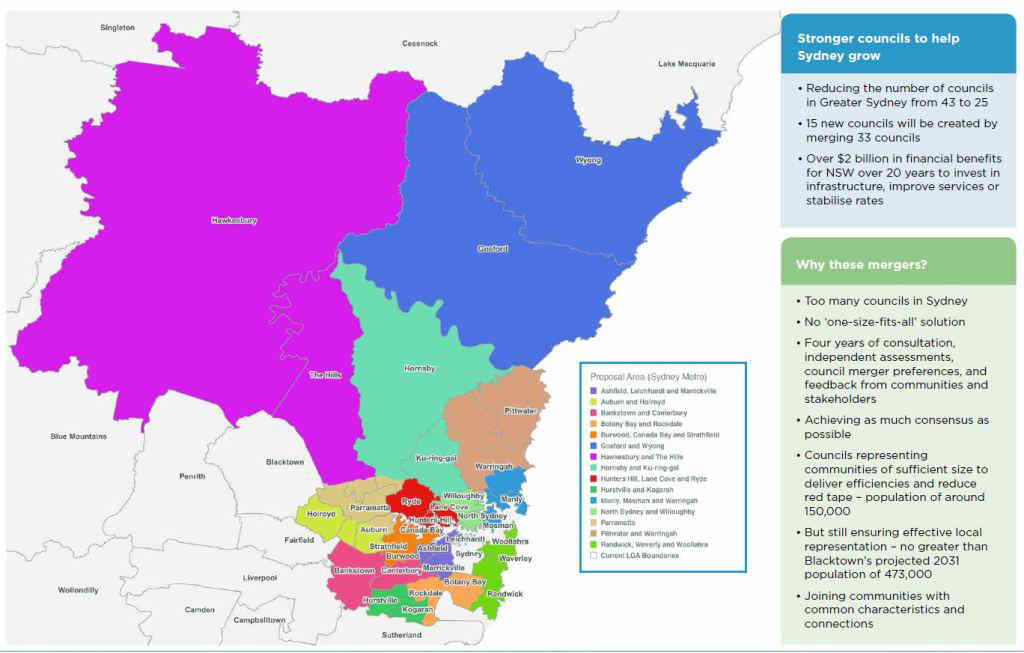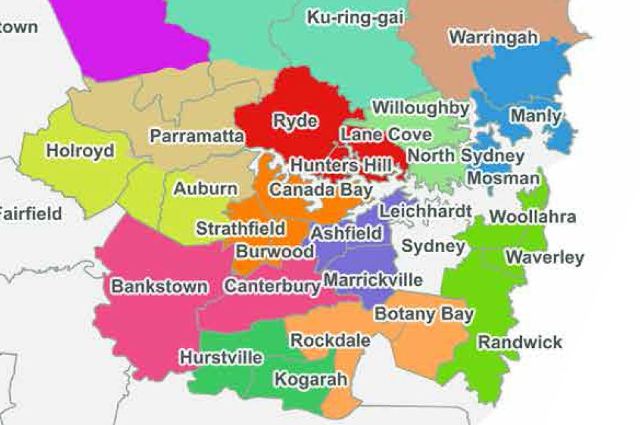
The NSW government has released maps of the state’s proposed council mergers, a plan that could ultimately eliminate local governments.
They come in the form of grainy, low resolution image files embedded into PDF documents, a notable departure from the slick and easily reproduced ‘info graphics’ favoured in other major government announcements.
Some of the most controversial forced council mergers are planned for Sydney’s Metropolitan north: Warringah will be carved in two: one chunk merging with Pittwater and another with Manly and Mosman.
Also on the cards is a merger between Hunters Hill; Hornsby and Ku-ring-gai; Lane Cove and Ryde and another between North Sydney and Willoughby.
The ‘Hands off Holroyd’ campaign will be bitterly disappointed at the government’s plan to merge it with part of Auburn Council, rarely out of the news these days due to its colourful Deputy Mayor, Salim Mehajer. Parramatta City Council will pick up another chunk of Auburn and snatch-up Sydney Olympic Park.
There will be disquiet in the regions as well. The council amalgamation protest rally in November was peppered with marchers from areas such as Dungog and Cabonne.
Dubbo and Wellington look set to merge, as do Orange, Cabonne and Blayney and Shellharbour and Woollongong.
The end result, if Premier Mike Baird gets his way, will be a reduction in Greater Sydney Councils from 43 to 25 and regional councils from 109 to 87.
With today’s (Friday) announcement, Sydney’s metro councils have finally learned what Premier Mike Baird’s definition of ‘scale and capacity’ is: 150,000 people or more.
This figure was not divulged during the Fit for the Future process and many councils failed the test on ‘scale and capacity’ without knowing where the benchmark was set.
It sets the scene for NSW local government to grow to almost three times the size of the average Queensland councils (54,800) and twice the size of the average Victorian council (63,000).
Local Government NSW President Keith Rhoades called the decision a “dark day for local democracy” and a “bully-boy farce” that he said would remove genuine local representation.
“It’s a cruel joke, and unfortunately the joke is on the people of NSW because they are the ones likely to lose any meaningful input on the issues that impact on their day-to-day lives,” said Mr Rhoades.
“LGNSW will continue to hold the Government to account throughout this process, which must be followed to the letter if the Minister wishes to avoid legal challenges.
“But it’s important to note that even though the review process offers an opportunity for community input, the Minister is in no way bound by its findings or recommendations, or that of the Boundaries Commission.
“As long as it has ticked all the procedural boxes as set out in the Act, the Government can essentially proceed to forced amalgamations at will.”
Premier Mike Baird heralded the mergers and said it would improve infrastructure and stabilise rates.
“Importantly, fewer councils will mean a big reduction in red tape for the NSW community and the businesses that work with councils,” Mr Baird said.
New councils will receive up to $10 million towards merger costs and up to $15 million for new community infrastructure.
Local government elections scheduled for September next year will be delayed, probably until March 2017.
The public consultation process will start in January, once detailed proposals are made available at www.councilboundaryreview.nsw.gov.au

New Sydney Councils
Ashfield, Leichhardt and Marrickville
Bankstown and Canterbury
Botany Bay and Rockdale
Burwood, Canada Bay and Strathfield
Hawkesbury and The Hills District
Holroyd and part of Auburn
Hornsby and Ku-ring-gai
Hunters Hill, Lane Cove and Ryde
Hurstville and Kogarah
Manly, Mosman and part of Warringah
North Sydney and Willoughby
Parramatta and part of Auburn
Pittwater and part of Warringah
Randwick, Waverley and Woollahra
New regional councils
Armidale-Dumaresq and Guyra
Bathurst and Oberon
Berrigan and Jerilderie
Blayney, Cabonne and Orange
Bombala, Cooma-Monaro and Snowy River
Boorowa, Harden and Young
Conargo and Deniliquin
Cootamundra and Gundagai
Corowa, Lockhart and Urana
Dubbo and Wellington
Dungog and Gloucester
Goulburn, Mulwaree and Palerang
Jerilderie and Murrumbidgee
Kiama and Shoalhaven
Murray and Wakool
Newcastle and Port Stephens
Palerang and Queanbeyan
Shellharbour and Woollongong
Tamworth and Walcha
Tumbarumba and Tumut






My first point of discussion is that the announcement was timed to be overlooked during the Christmas break – That seems a very sneaking way to announce something that will affect a huge proportion of the State!
Next, I don’t see a lot of respect for residents in the whole process. I’ve lived through a couple of large business mergers. Even when two businesses are roughly the same size, there is usually an internal tussle between the two cohorts of the former organisations. It is a huge waste. I doubt the projected savings will be as large as politicians suggest. As a rule of thumb when someone promises a net gain in politics, I discount it by a third or a quarter.
Finally, local government is often one of the largest employees in regional areas. Often the councils are reservoirs of skills and technology that would be unsustainable in a local area. Viable communities need access to tech-savvy people via some path. Since councils will be amalgamating, what has the State government planned to do for those loosing their jobs? What about a plan to ensure decentralised resourcing, to spread wealth and expertise throughout a community?!
I refer to the proposed amalgamation between Lane Cove, Hunters Hill and Ryde. As a ex Councillor I am firmly of the view that there is no ‘community of interest’ between Lane cove or Hunters Hill on the one hand and Ryde on the other. If there had to be an amalgamation whereby Lane Cove is merged then the merger should be with North Sydney/Willoughby.
The strength of the local government is that is close to the ‘grass roots’ and individual councillors can directly deal with constituents without the imposition of paid staff. In relation to development and building applications, sites are inspected by all councillors as a group prior to the application being approved. I cannot see how this valuable procedure can continue with enlarged council areas.
Re walcha,s amalgamation with Tamworth what a joke how can Tamworth council service some of the areas of walcha when they are up to 200 kilns away in
Some areas there will be no road maintenance done when it should be or any other maintenance for that matter these people we vote for should and might I add pay top dollar for get something between their ears besides fresh air !! Uralla were allowed to stand alone so should walcha considering their financial position the ratepayers are going to have to fight it because do nothing Kevin will be out of town when the meeting is on??
It’s Good. I support it
fangluo
I would like to know more about the councils that will merge.
In the mid 1990s The Bulletin magazine published an article about Kelty and Keating’s meeting in a restaurant during which they designed new council borders. The meeting led to a conference in Canberra to create new borders.
Councils are a matter for the States and none of the federal government’s business.
Around the time of the conference, a notion was proposed to organise council borders according to geographical features, across State borders, to make the States seem irrelevant. States, however, are the sovereign entity and the federal government is a servant of the States – that’s why the States employ the Senate to oversee the PM and the PM’s government.
PM Keating wanted to centralize power in the federal government to enable Australia to be dissolved into the Asia-Pacific region, in the manner of the European Union. The Republic issue was ostensibly about making Australia independent of Britain but it was also about making Australia a State of Asia. He wanted an Asia-Pacific currency based on the Japanese Yen, which collapsed soon afterwards and has not yet revived.
Keating’s ‘undisclosed external agenda’ to merge the councils will continue regardless of economic needs. Many studies have concluded that amalgamation does not always result in beneficial financial outcomes.
In 2009 PM Rudd stated that Europe was the best model we had. Some people are sceptical about it but someone must take the first step. His plan was for Australians to have the same currency, laws, wages and conditions as the rest of Asia. Australians would be unlikely to follow his lead if they knew its destination. Immediately after his speech Europe collapsed and has not yet revived.
Councils and States are being forced to ‘tighten their belts’ because PM Rudd and Treasurer Swann borrowed hundreds of thousands of millions of dollars that they (like US and Britain during the Global Financial Crisis) could have had ‘printed’ in order to keep Australia debt-free. The proper course would have been for Australia’s Treasury/RBA to have printed enough money to have enabled a stable economy and employment, and to have loaned the money to the States, with an interest debt to prevent inflation. The States would have returned the money to the Treasury and subsequently the federal government would have spent this money on the states – a circular economy. We would by now owe nothing to foreign lenders.
Instead, Rudd/Swann did what an inebriated sociopath wearing underpants as a hat might have suggested: “Let’s save the economy by borrowing squillions of dollars and spending them!” As a result Australians will take many decades to repay the debt and governments will attempt to extract more money from citizens.
P.S. the attempt to make councils a separate entity through the abandoned referendum was a carnival con trick. The Gillard government would have offered the new ‘Council Government’ a two-for-one deal. She could only have offered two million dollars (of debt!) for every one million dollars of debt-free ratepayers money that the Council Government would have contributed. The council’s money would have been appropriated to pay out federal debt (see the similar Gonsky funding con). Note that the people who proposed a separate Local Council level of government were the same people who ten minutes earlier had been telling us that Australia has too many levels of Government. Note also that no-one ever proposes that we remove the federal government, the easiest level to remove. It would be to difficult to sell out Australia without a central government.
Council amalgamation was a total disaster in north queensland and proven to have no merit…. duplication of costs for taxpayers with no increase in service and depending upon where people sit , there will be bias in the amalgamated council that will then focus more on one area than another…